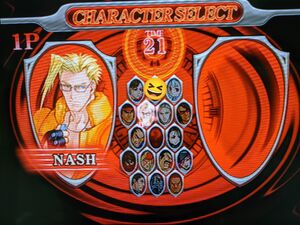Capcom Fighting All-Stars: Code Holder was a 3D fighting game planned for the arcade and PlayStation 2 that was to be developed by Capcom.
Development
Originally, Capcom Fighting All-Stars was planned to be a 2D sequel to Capcom vs. SNK 2: Mark of the Millennium 2001, before being converted to 3D. However, due to SNK's financial troubles and restructuring, the title was redesigned as a Capcom-only crossover with twenty former SNK members designing it, using the models previously built for the original title.[1]
Like SNK's KOF: Maximum Impact games, it was designed to translate a 2D fighting game series into 3D. This was done previously in the Street Fighter EX series, which Capcom co-produced with Arika.
Capcom beta-tested the game, but after negative feedback from players and more months in development, the game was canceled in August 2003.
According to an interview with former The King of Fighters director Toyohisa Tanabe, a secret character from Tanabe's old company (SNK) was set to be playable in Capcom Fighting All Stars.[2][3]. While not confirmed, the figure bears a heavy resemblance to both Kyo Kusanagi and K'.
Gameplay
The life system was 3-tiered: if the player lost one tier, a break moment would occur and then the fight would resume, much like the life system in Vampire Savior. However the life system was also linked to the power bar: for each tier lost, a character gained an additional level in the Super Combo gauge (at full life, a character only has single-level super combo moves). Super arts were handled in three tiers, each super costing one, two, or three levels to use them.
As a 3D game, there was a dodge system along with Dramatic Counter, a special dodging counterattack that slowed the game down on successfully activating it, not unlike a V-Shift. Prior to a match, a player could also perform a Declaration of Victory, where they would taunt an opponent prior to the match. After doing so, they would instantly lose the entire game if they lost a single round, but would receive a score bonus if they won. Atypical for Capcom fighting games was the Dramatic Finish, a cinematic finishing move similar to a Fatality in the Mortal Kombat series that required a successful Declaration of Victory and a complicated input to pull off.
Many parts of the system were later used in Capcom Fighting Evolution for Ingrid's gameplay and Capcom later revisited the concept of 2D fighters in 3D with the more traditional Street Fighter IV and Tatsunoko vs. Capcom.
Characters
Overall, there were 16 planned characters for Capcom Fighting All-Stars, 9 of which would originate from the Street Fighter shared universe (5 from street fighter, 2 from Final Fight, and 2 from Rival Schools) and one each from the Darkstalkers and Strider series. 4 original characters, collectively known as the Code Holders, were to be introduced in this game, one of which would later make a playable appearance in the Street Fighter series (Ingrid). In addition, there was to be a guest character from SNK Corporation.[4]

Story
The shadow of fear was approaching Metro City.
A man only known as Death, was running around Metro City with a bomb. The bomb was codenamed "Laughter Sun". Mayor Mike Haggar contacted the characters listed above in order to locate and defeat Death and then defuse the bomb. Codes were needed to disarm the bomb, and that is where the Code Holders subtitle of the game comes into play. D.D. and his teammates, Rook and Ingrid, were the Code Holders. Their codes are Ogre, Fallen Angel, and Isis.
The game had a time limit, and depending of how long the player took to finish the game, the ending would vary.[5]
Legacy
While the game never received an official release, the idea of Capcom's own characters in a crossover game would be instead used in a 2D fighting game, Capcom Fighting Evolution, released in 2004. One of the original characters slated to debut in All-Stars, Ingrid, would appear in Evolution and later on in Street Fighter Alpha 3 MAX for the PlayStation Portable.
Two unique ideas used in the game were "Breaks" between rounds and finishing moves similar to the "Fatality" concept used in the Mortal Kombat series. Subsequent Capcom fighting games do not feature these ideas.
In August 2016, new info and images for the game were added on the Street Fighter V encyclopedia site, including new unreleased posters (some made by Shinkiro, the artist who drawed the promotional arts from Capcom Fighting Evolution and Tatsunoko vs. Capcom) and the full reveal of the final boss Death (who was for many years only seen as a silhouette in one of the game flyers).[6] Takayuki Nakayama has posted various screenshots of the game, including ones of Death, suggesting that the unreleased arcade game still exists within the offices.
Gallery









































Video
References
- ↑ https://www.polygon.com/2021/1/7/22214717/capcom-vs-snk-an-oral-history
- ↑ https://game.capcom.com/cfn/sfv/column/132053
- ↑ https://game.capcom.com/cfn/sfv/column/secret.jpg?h=8e14626325d1d427cf919b5457c3fa2a
- ↑ https://game.capcom.com/cfn/sfv/column/132053
- ↑ Street Fighter V: Interview with Toyohisa Tanabe
- ↑ Street Fighter V Treasures: Fighting All-Stars Materials
External Links
- Capcom Fighting All-Stars at Final Fight Online
- Capcom Fighting All-Stars page from the Fighters Frontline (Japanese)
- Capcom Database article



